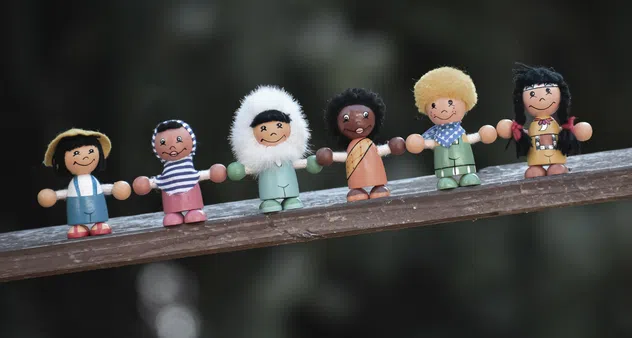The writing questionnaire
You’re a screenwriter. Your stories and characters inspire and/or influence viewers who enter your imaginary world. You’re looking to incorporate elements of a more inclusive and sustainable society into your story lines.
This guide includes questioning themes based on the cornerstones of story development: the characters, the societal model and the characters’ mission. You will find a summary of the guide on this page. The full guide includes approximately thirty questions and is available for download. Its quick and easy-to-use format invites you to reflect upon your story without hindering your creativity and without there being any right or wrong answers. This questionnaire is not an exhaustive list. Feel free to make it your own and use it to guide you in your screenwriting goals.

Who are your characters?

Parity, inclusion, disability, and cultural, ethnic, and social diversity… Our history and societies are the product of a profound diversity that contributes to their strength and value.
The goal of this chapter is to reflect upon how your main and secondary characters are established and whether they reflect our social diversity. Without imposing quotas, these questions allow you to explore the diversity of your characters and how it impacts your story.
A few key figures
3.57%
of interactions involving three characters are between 3 women, compared with 40.74% between three men.
Using data science to understand the film industry’s gender gap, 2020
2.8%
of the characters in
prime-time TV series in the US in 2021 have a disability, whereas disabled people represent 26% of the American population.
GLAAD, 2022
38.9%
of lead actors in theatrical and streaming Hollywood films produced in 2021 are people of color.
UCLA, 2022
47.2%
of lead actors in films released in 2021 are women.
UCLA, 2022

What is your characters’ mission?

The concept of “success” includes many facets that go beyond those conveyed by the current dominant models (financial gain, the appeal of power, etc.).
This part of the guide offers ways to explore and highlight new sources of personal and collective fulfilment and development by reflecting upon characters’ aspirations and their understanding of current issues. Instead of creating smooth or predictable characters, this section takes into account the contradictory nature of human beings and leads them to new, more contemporary reflections.
A few key figures
64%
of the world’s
population considers climate change to be an emergency.
UNDP & Oxford University, 2021
77%
of survey respondents report having learned about a social or environmental issue through fictional TV or film.
A Glaring Absence, 2021
0,6%
of the 37,453 film and TV scripts analyzed by researchers at the University of Southern California specifically mentioned “climate change”.
A Glaring Absence, 2021
3
films nominated for the
2024 Oscars are set in a society where climate change is present.
Climate Reality Check, 2024

Which societal model serves as a backdrop for your story?

Our consumption of natural resources exceeds what the Earth is able to replenish in a year. According to Earth Overshoot Day, it would take 1.75 Earths to regenerate what we consume.
Because humanity will have to adapt to these fixed planetary limits, the goal of this chapter is to reflect upon your characters’ habits and lifestyles (their relationship with consumption, nature, etc.) in order to identify other models that are more compatible with the resources actually available.
A few key figures
80%
This percentage represents the relative average duration of nature scenes in Walt Disney films in the 1940s, versus 50% in the 2000s.
Public Understanding of Science, 2014
1.75
At current global consumption levels, we would need 1.75 Earths to meet our needs (5.1 Earths if every human consumed like an American).
Earth Overshoot Day article, 2022
25%
of the world’s population lives in a country facing extremely high water stress throughout the year, using more than 80% of available water resources, resulting in a high risk of water shortages.
World Resources Institute
69%
of vertebrate populations disappeared between 1970 and 2018.
WWF Living Planet Report, 2022


The testimony of Jack Cooper Stimpson, Writer and Director:
The climate crisis deserves robust and imaginative storytelling. This is an existential issue and often evades ordinary thought and feeling. How do we convey the emotions of response, togetherness and adaptation through our scripts and inspire audiences to act?
I’ve often approached climate-storytelling via the lens of activism and civil-disobedience. Having been attracted to the comedy and chaos of protest, I’ve found characters who haven’t really existed in the mainstream media before. I discovered characters with big ideas and big emotions, who are quite often trying to overcome enormous challenges. Challenges well beyond their typical capabilities. The dynamics and scenarios that these characters find themselves in help portray both the enormity of the issue at the hand, the futility of trying to fix a broken system. But they also remind us of the human connection at the heart of the crisis. Being an activist can often feel like you’re a headless-chicken, doing your best to make change but quite often failing with spectacular effect. The trial and error of activism is something to celebrate and find comic relief in.
In 2019, I wrote and directed ‘Extinction’. A comedic satire about Extinction Rebellion. The film starred Emma Thompson and needed to engage viewers, without ever feeling preachy or worthy. We relied on comedy to convey the urgency of the movement we were portraying. This tone and genre helped us properly exmaine the beautiful intricacies of being an activist. The mistakes, the mishaps, the general state of confusion. We were able to make jokes about our characters, because ultimately, they’re in the right. These are ordinary people doing exctraordinary things to try and save the planet. The climate crisis is a terrifying thing, but an old saying often comes to mind: if you don’t laugh, you cry.